Background
Legend says that the islet was named after the Norwegian Baron Kitter who supposedly ruled the Isle of Man. After killing all the deer, bison and elk on the mainland, he sailed to the Calf of Man to hunt there. While on the Calf his castle at Barrule was accidentally set on fire. Seeing his house in flames across the water he rushed back, but his boat foundered and he drowned. The islet was named after this accident.
According to a Manx legend, [1] Baron Kitter's hunting wiped out all the animals of the Calf, and the people of Mann were afraid he would begin hunting their own beasts. So, they asked the wisest witches of the island to help them. One day while Baron Kitter was on the isle of Calf, his cook Eaoch of the Loud Voice fell asleep. The witch Ada put a spell on the pot so that it boiled over, setting the castle on fire.
Kitter's friends, who had stayed on the Calf, decided that Eaoch had plotted with the witch to kill off the Norwegians and had him brought before the Norwegian-born King Olaf, who sentenced him to death. Norwegian custom allowed him to choose the manner of his own death, so Eaoch said he wished to have his head laid across the king's legs and cut off with the king's own sword, which was named Macabuin. It was made by Loan Maclibuin the Dark Smith of Drontheim, and could cut the through hardest granite just by touching it. The Norwegians begged the king to refuse, but he would not break his word and gave orders to proceed. However, the witch Ada was there, and told them to lay nine times nine toads' skins, cuirn tree twigs and adders' eggs across the king's legs. When the sword was laid gently on Eaoch's neck, it instantly cut it off and cut through the adders' eggs and the cuirn tree twigs as well - only the toads' skins saved the king's legs. [2]

The Isle of Man or Mann, is a self-governing British Crown Dependency in the Irish Sea, between Great Britain and Ireland. It is one of the Celtic nations and is the homeland of the Manx people, a Celtic ethnic group. As head of state, Charles III holds the title Lord of Mann and is represented by a Lieutenant Governor. The government of the United Kingdom is responsible for the Isle of Man's military defence and represents it abroad, but the Isle of Man still has a separate international identity.
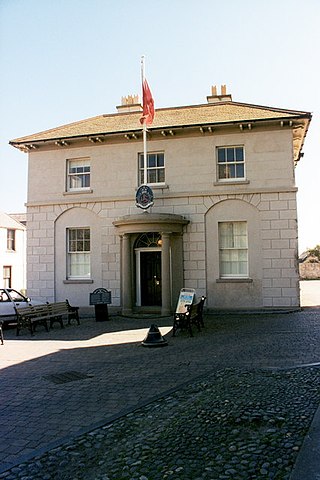
The Isle of Man had become physically separated from Great Britain and Ireland by 6500 BC. It appears that colonisation took place by sea sometime during the Mesolithic era. The island has been visited by various raiders and trading peoples over the years. After being settled by people from Ireland in the first millennium AD, the Isle of Man was converted to Christianity and then suffered raids by Vikings from Norway. After becoming subject to Norwegian suzerainty as part of the Kingdom of Mann and the Isles, the Isle of Man later became a possession of the Scottish and then the English crowns.

The Isle of Man is an island in the Irish Sea, between Great Britain and Ireland in Northern Europe, with a population of almost 85,000. It is a British Crown dependency. It has a small islet, the Calf of Man, to its south. It is located at 54°15′N4°30′W.

Fionn mac Cumhaill, often anglicized Finn McCool or MacCool, is a hero in Irish mythology, as well as in later Scottish and Manx folklore. He is the leader of the Fianna bands of young roving hunter-warriors, as well as being a seer and poet. He is said to have a magic thumb that bestows him with great wisdom. He is often depicted hunting with his hounds Bran and Sceólang, and fighting with his spear and sword. The tales of Fionn and his fiann form the Fianna Cycle or Fenian Cycle, much of it narrated by Fionn's son, the poet Oisín.

Tynwald, or more formally, the High Court of Tynwald or Tynwald Court, is the legislature of the Isle of Man. It consists of two chambers, known as the branches of Tynwald: the directly elected House of Keys and the indirectly chosen Legislative Council. When the two chambers sit together, they become "Tynwald Court".
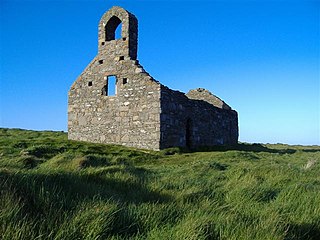
St Michael's Isle, more commonly referred to as Fort Island, is an island in Malew parish in the Isle of Man, noted for its attractive ruins. It covers an area of 5.14 hectares, is about 400 metres long from west to east, and is connected to the Langness Peninsula, near Derbyhaven, by a narrow causeway. The island itself is made of rocky slate and the soil is very acidic. Nevertheless, it has important communities of maritime plants.
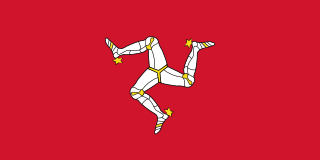
The flag of the Isle of Man is a triskelion, composed of three armoured legs with golden spurs, upon a red background. It has been the official flag of the Isle of Man since 1 December 1932 and is based on the Manx coat of arms, which dates back to the 13th century.
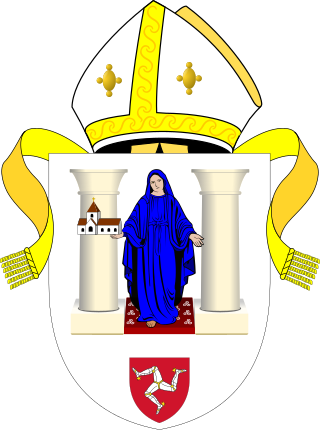
The Diocese of Sodor and Man is a diocese of the Church of England. It is one of only two Church of England dioceses not within the United Kingdom. Originally much larger, today it covers just the Isle of Man and its adjacent islets. Today, the bishop's office is in Douglas and the cathedral is in Peel. The diocese is not generally called either "Sodor diocese" or "Man diocese".
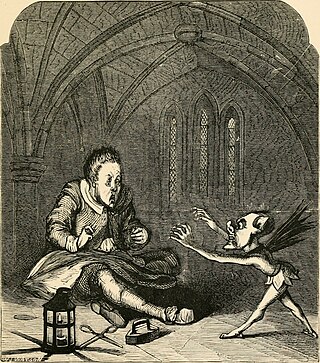
In Manx folklore, a buggane was a huge ogre-like creature native to the Isle of Man. Some have considered them akin to the Scandinavian troll.

Peel Castle is a castle in Peel in the Isle of Man, originally constructed by Norwegians. The castle stands on St Patrick's Isle, which is connected to the town by a causeway. It is now owned by Manx National Heritage and is open to visitors during the summer.

Wren Day, or Hunt the Wren Day, is an Irish and Manx custom on 26 December, Saint Stephen's Day. Traditionally, men and boys hunted a wren and placed it on top of a staff decorated with holly, ivy and ribbons, or displayed it in a decorated box on top of a pole. This was paraded around the neighbourhood by a group of 'Wrenboys'—typically dressed in straw masks, greenery and colourful motley clothing—who sang songs and played music in exchange for donations. On the Isle of Man, the people afterwards held a funeral for the wren and danced around the wren pole. Wren Day has been undergoing revival since the late 20th century, although the wren is no longer hunted and a stuffed wren is used instead. There were similar New Year traditions in parts of Britain and France until the nineteenth century.

The culture of the Isle of Man is influenced by its Celtic and, to a lesser extent, its Norse origins, though its close proximity to the United Kingdom, popularity as a UK tourist destination, and recent mass immigration by British migrant workers has meant that British influence has been dominant since the Revestment period. Recent revival campaigns have attempted to preserve the surviving vestiges of Manx culture after a long period of Anglicisation, and significant interest in the Manx language, history and musical tradition has been the result.

Manx English, or Anglo-Manx, is the historic dialect of English spoken on the Isle of Man, though today in decline. It has many borrowings from Manx, a Goidelic language, and it differs widely from any other variety of English, including dialects from other areas in which Celtic languages are or were spoken, such as Welsh English and Hiberno-English.
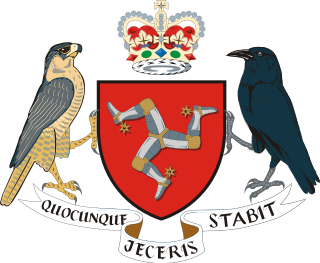
The coat of arms of the Isle of Man, blazoned Gules three legs in armour flexed at the knee and conjoined at the thigh, all proper, garnished and spurred or, dates from the late 13th century. The present version dates from 12 July 1996. As the Isle of Man is a Crown dependency and the present Lord of Man is King Charles III of the United Kingdom, the arms are more accurately described as the arms of His Majesty in right of the Isle of Man. The origin of the triskeles is obscure, but it appears to stem from the Scottish takeover of the island in 1265. The heraldic supporters are birds associated with the island, whilst the motto first appears on record in the 17th century.

The Skanke family is a former Norwegian noble family.
The Moddey Dhoo is a phantom black dog in Manx folklore that reputedly haunted Peel Castle on the west coast of the Isle of Man. The Manx name Moddey Dhoo was transcribed as Mauthe Doog by an influential 18th-Century English-speaking folklore source, which led to a history of misspellings of the proper name.
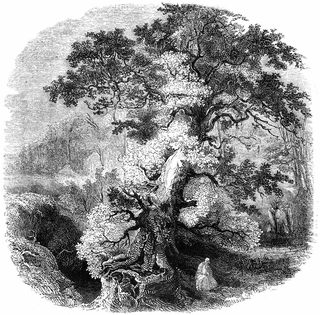
Many types of trees found in the Celtic nations are considered to be sacred, whether as symbols, or due to medicinal properties, or because they are seen as the abode of particular nature spirits. Historically and in folklore, the respect given to trees varies in different parts of the Celtic world. On the Isle of Man, the phrase 'fairy tree' often refers to the elder tree. The medieval Welsh poem Cad Goddeu is believed to contain Celtic tree lore, possibly relating to the crann ogham, the branch of the ogham alphabet where tree names are used as mnemonic devices.
John Joseph Kneen was a Manx linguist and scholar renowned for his seminal works on Manx grammar and on the place names and personal names of the Isle of Man. He is also a significant Manx dialect playwright and translator of Manx poetry. He is commonly best known for his translation of the Manx National Anthem into Manx.
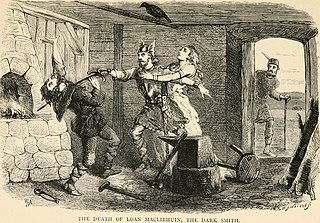
Loan Maclibuin was a legendary Norwegian smith. He was known as "The Dark Smith of Drontheim". He was the seventh son of Windy Cap, King of Norway. The "dark", does not refer to his working black magic, but rather to his swarthy nature.


















